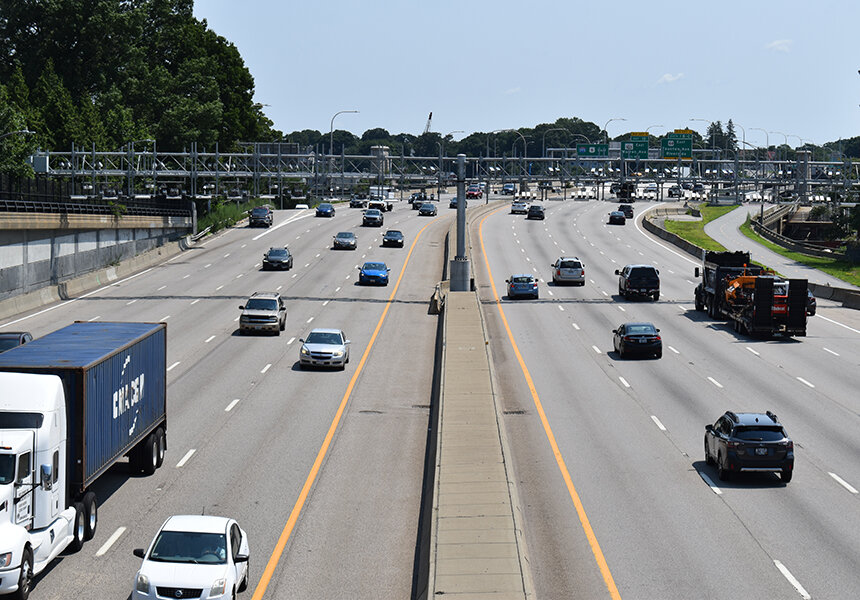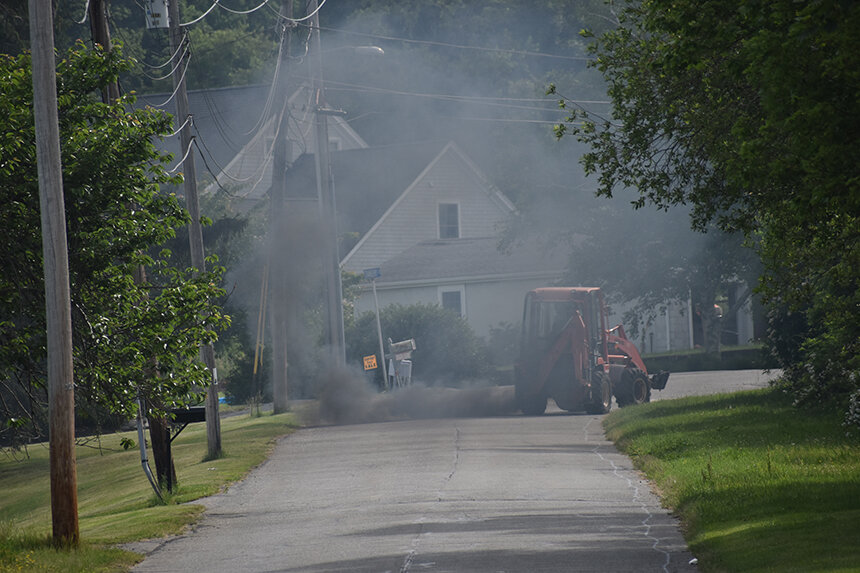
The heavy-duty diesel vehicles in the West- and East-bound lanes of Interstate 195 aren’t subject to the same emissions testing as the light-duty vehicles around them. (Frank Carini/ecoRI News)
By CAITLIN FAULDS/ecoRI News staff
In mid-July, 21 years ago, a law was passed to crack down on diesel emissions emanating from Rhode Island’s largest vehicles.
The amendment to the state’s General Law (§ 31-47.2) acknowledged that heavy-duty diesel vehicles contribute significantly to air pollution and diminished “the quality of life and health” of all Rhode Island residents.
“It is in the public interest to establish a program regulating exhaust emissions from heavy-duty diesel trucks and buses traveling within Rhode Island,” the law stated. It directed the Division of Motor Vehicles (DMV) and the Department of Environmental Management (DEM) to tackle the issue and launch such a program by 2003.
As of this month, according to state officials, “the program has not yet commenced.”
“I’m not exactly sure why, what’s taken so long,” said Laurie Grandchamp, administrator of DEM’s Office of Air Resources, when asked by ecoRI News why the emissions testing program is still in development 18 years after it was supposed to be implemented.
“We really haven’t done anything with the heavy-duty [emissions],” she said, “and so there really isn’t a program that I can speak to because, I mean, it’s in its infancy.”

Black smoke from heavy-duty diesel vehicles, such as this non-road tractor driving on a public street in Portsmouth, is a sign that unhealthy levels of particulate matter are spewing into the air. (Frank Carini/ecoRI News)
Dangerous emissions
Heavy-duty (HD) vehicles are broadly defined by the Environmental Protection Agency (EPA) as those weighing more than 8,500 pounds. The on-road HD designation includes mostly diesel-powered long-haul trucks and urban buses, and stretches down to incorporate large cargo vans and hefty pickups.
Non-road HD vehicles, including marine vessels, aircraft, and construction and agriculture equipment, face differences in testing and enforcement.
On-road HD vehicles represent about 5 percent of the nation’s traffic. But, according to the Environmental and Energy Study Institute, they emit about 20 percent of all transportation emissions.
These emissions include carbon dioxide and monoxide, nitrogen oxides and ultrafine particulate matter (PM). All are associated with a host of environmental and public health impacts, from water eutrophication and climate change to cardiovascular disease and respiratory damage.
A Harvard University and University of North Carolina study published earlier this year estimated that exposure to PM and ozone originating from vehicle emissions in the Northeast in 2016 led to the premature death of more than 7,000 people. According to the study, emissions from HD trucks and buses were to blame for 1,762 of those deaths.
Socioeconomically disadvantaged communities, often located near highways and shipping corridors, are known to bear the brunt of emission-related health effects.

Heavy-duty vehicles represent about 5 percent of the nation’s traffic, but emit about 20 percent of all transportation emissions. (istock)
Different standards
Every two years, Rhode Island-registered light-duty vehicles — Honda Civics, Ford Explorers and the like — are required to undergo a $55 safety and emissions test at one of 330 inspection stations in the state.
HD vehicles instead face an annual $15 safety inspection, which takes about two hours to complete and checks the physical components of the truck, including its lights, wheels and brakes. A thorough emissions check is not included.
According to a statement provided by DEM chief public affairs officer Michael Healey, DEM and DMV are working together to develop a Heavy-Duty Inspection and Maintenance (HD I&M) program that will include diesel emissions testing.
Opus Inspection Inc. — a global vehicle inspection company that currently runs Rhode Island’s light-duty program — was contracted in April 2018 by the state to run the HD I&M program. A project schedule included in the contract indicated that testing was expected to launch by January 2020.
“I’ll be honest, we’re at the very preliminary stages,” Grandchamp said when asked for details about the long-delayed program. “There really isn’t anything for me to talk about because we’re really not there yet. We had hoped that they would be developed by this point, however, COVID has delayed them.”
The coronavirus pandemic forced a state of emergency in Rhode Island beginning on March 9, 2020 — two months after the scheduled start date.
According to DMV spokesperson Paul Grimaldi, test methods are now expected to be defined by the end of this year with a program launch no later than 2023.
“Equipment has been ordered and software is currently under development by Opus Inspection,” said Grimaldi, chief of information and public relations with the Department of Revenue, which houses the DMV.
According to the DEM website, state and local police perform roadside checks to help “enforce motorist compliance with the HD emissions standards.” But Healey said DEM and DMV had no information about the roadside checks beyond what was listed on the website.
“Questions should be directed to the Rhode Island State Police,” he said.
When asked by ecoRI News, Maj. Laurie Ludovici, administrative bureau commander with the Rhode Island State Police, said the State Police Commercial Enforcement Unit was not involved in emissions checks.
“Heavy-duty vehicle emissions testing [is] not done by the State Police, not done roadside,” she said. “[It’s] all done by the Rhode Island Division of Motor Vehicles.”

Illegal emissions tampering on diesel trucks is a common occurrence, according to Rhode Island automotive mechanics and technicians. (Green Car Reports)
Emissions tricks
According to emissions expert Michael Walsh, who contributed to a 1997 HD emissions report for Northeast States for Coordinated Air Use Management (NESCAUM), an association of New England air quality agencies whose board of directors includes Grandchamp, HD emissions standards have seen progress over the years.
In the 1990s, emissions were identified by spotting black smoke streaming out from trucks, Walsh said. Since then, particulate filters, two-way catalytic converters with nitrogen oxide adsorbers and other exhaust-system technologies have helped reduce HD emissions by more than 70 percent.
By the late 2000s, Rhode Island prohibited the unnecessary idling of diesel vehicles and began receiving EPA funds through the Diesel Emissions Reduction Act to replace older diesel engines, especially those in government fleets.
Federal policy, too, has lurched along, pulled forward by the California Air Resources Board — the “world leader” in air quality standards, according to Walsh. The EPA is currently working to update its standards for the first time in two decades. According to Coralie Cooper, deputy director of NESCAUM, the federal agency will need to match California’s newest regulations to significantly improve air quality.
Currently, truck manufacturers are federally obligated to submit annual emissions reports proving compliance with greenhouse-gas standards. But, as demonstrated by the Volkswagen scandal, there are issues in relying on manufacturer-reported emissions values and data gaps relating to in-use emissions.
“Once the vehicle leaves the lot and it’s purchased, that’s where the federal government control of emissions ends,” Cooper said. State I&M programs are all-important from then on out as a “checkup” to ensure components remain intact and emissions stay low throughout a vehicle’s lifespan.
These I&M programs help ensure that built-in emissions components are not left in disrepair or, Cooper said, even fully removed from the vehicle.
Though tampering is prohibited by the federal Clean Air Act, the EPA estimates that between 2009 and 2019 emissions controls were removed from more than 550,000 diesel trucks nationwide. According to the report, these altered trucks contribute as many emissions as 9 million unaltered, EPA-complaint vehicles.
Anthony Frattarelli, service manager at Smithfield Diesel & Transmission Repair in Smithfield, said he often sees personal and commercial diesel vehicles come through his garage doors with altered emissions systems.
Emissions components can “drive you nuts,” he said, because even though the components themselves are not tested, they can result in a failed safety check and incur expensive repairs. People buy elite kits online for $1,500 to $3,000, he said, to “save some money” and gain horsepower.
His shop doesn’t install these kits, but Frattarelli said there wouldn’t be any consequence if it did, as there is little enforcement of the federal law.
Down the road at Allegiance Trucks in Warwick, service director Henry Melvin said he regularly turns tampered vehicles away from his shop for fear of being held liable if the state does eventually tighten regulations.
“We’re still doing inspections we did 30 years ago,” he said. “I think it’s something that the state of Rhode Island needs to take serious.”
Electric avenue
According to Walsh, a strong I&M program would help the state limit HD emissions. But faced with today’s climate “catastrophe,” he said, I&M alone is no longer enough.
“The major thrust on heavy-duty vehicles … today is really trying to electrify the fleet as rapidly as possible,” he said.
Last July — nearly 20 years to the day since Rhode Island’s diesel testing law was passed — then-Gov. Gina Raimondo signed a memorandum of understanding promising to drastically reduce emissions by fully electrifying HD vehicle sales by 2050.
In the non-binding pledge, Rhode Island agreed to work with other states in the region to “accelerate the deployment of zero-emission medium- and heavy-duty trucks and buses.” The transition to electric, it said, would “benefit disadvantaged communities that have been historically burdened with higher levels of air pollution.”
It’s a necessary shift, Cooper said, but one that won’t happen overnight.
“Diesels are going to be around for a while,” she said. “It takes, you know, a good 15 years for the fleet to turn over entirely.”
"heavy" - Google News
July 30, 2021 at 06:41PM
https://ift.tt/2UZ33zc
Heavy-Duty Vehicle Emissions Go Unchecked Decades After Rhode Island Law Mandated Inspections — ecoRI News - ecoRI news
"heavy" - Google News
https://ift.tt/35FbxvS
https://ift.tt/3c3RoCk
heavy
Bagikan Berita Ini














0 Response to "Heavy-Duty Vehicle Emissions Go Unchecked Decades After Rhode Island Law Mandated Inspections — ecoRI News - ecoRI news"
Post a Comment